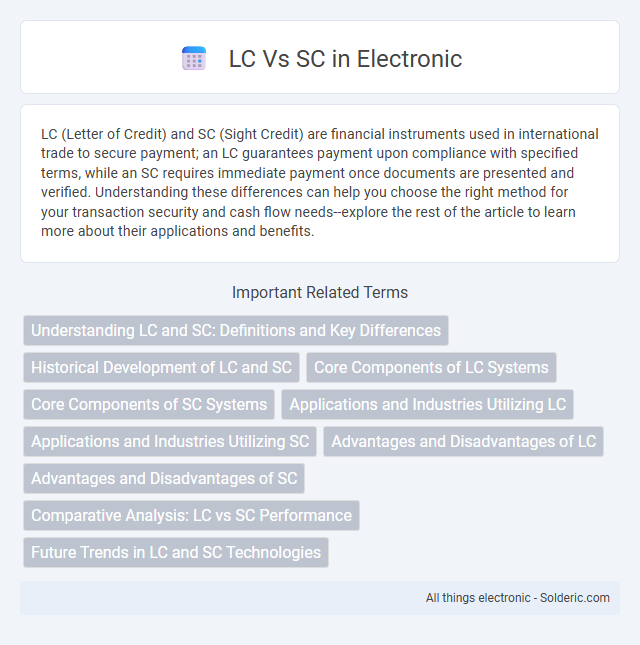LC (Letter of Credit) and SC (Sight Credit) are financial instruments used in international trade to secure payment; an LC guarantees payment upon compliance with specified terms, while an SC requires immediate payment once documents are presented and verified. Understanding these differences can help you choose the right method for your transaction security and cash flow needs--explore the rest of the article to learn more about their applications and benefits.
Comparison Table
| Feature | LC (Letter of Credit) | SC (Standby Letter of Credit) |
|---|---|---|
| Purpose | Primary payment method in trade transactions | Backup payment guarantee in case of default |
| Usage | Facilitates import/export payments | Acts as secondary security for obligations |
| Trigger | Payment made upon presenting compliance documents | Payment triggered only if applicant defaults |
| Risk | Minimizes payment risk by bank guarantee | Minimizes credit risk as a safety net |
| Parties Involved | Applicant, Beneficiary, Issuing Bank, Advising Bank | Applicant, Beneficiary, Issuing Bank |
| Common Use Cases | International trade financing | Contract performance guarantee, loan backup |
| Payment Condition | Payment upon document conformity | Payment upon default or failure to pay |
Understanding LC and SC: Definitions and Key Differences
Letters of Credit (LC) and Standby Letters of Credit (SC) are essential financial instruments used in international trade to ensure payment security. LC guarantees payment to the exporter upon presentation of compliant documents, while SC acts as a secondary payment method, only payable if the buyer defaults. Understanding these key differences helps you choose the right instrument to manage risks and secure transactions effectively.
Historical Development of LC and SC
Letters of Credit (LC) originated in the medieval trade practices of Europe, evolving to facilitate secure international commerce by guaranteeing payment under specified conditions. Standby Letters of Credit (SC) emerged later as a financial instrument designed to back contractual obligations, serving as a safety net when primary payment methods fail. Understanding the historical development of LC and SC enables you to leverage their distinct functions effectively in global trade and risk management.
Core Components of LC Systems
The core components of Letter of Credit (LC) systems include an issuing bank, the applicant (buyer), the beneficiary (seller), and the advising or confirming bank which ensures payment security. LC systems involve strict documentation requirements such as invoices, transport documents, and inspection certificates to trigger payment. Understanding these elements helps you manage trade risks and secure international transactions effectively.
Core Components of SC Systems
Supply chain (SC) systems consist of core components including procurement, inventory management, transportation, and demand forecasting, which collectively optimize the flow of goods and information. Lifecycle (LC) management integrates product design, manufacturing processes, and end-of-life disposal, emphasizing sustainability and efficiency throughout a product's existence. Effective SC systems leverage advanced analytics and automation tools to enhance operational visibility and responsiveness.
Applications and Industries Utilizing LC
Letters of Credit (LC) are extensively used in international trade, particularly in industries like manufacturing, agriculture, and energy to secure payment and mitigate risks. Manufacturers in electronics and automotive sectors rely on LCs to ensure timely payment while importing raw materials or exporting finished goods. Conversely, Standby Letters of Credit (SC) are commonly utilized in construction, telecommunications, and financial services as a guarantee of performance or payment if contractual obligations are not met.
Applications and Industries Utilizing SC
Supply Chain (SC) management is widely employed across diverse industries such as manufacturing, retail, healthcare, and logistics to optimize procurement, production, and distribution processes. Industries leveraging Supply Chain include automotive, consumer electronics, pharmaceuticals, and food and beverage, where efficient resource allocation and inventory control are critical. Advanced Supply Chain strategies enhance operational efficiency, reduce costs, and improve customer satisfaction by streamlining the flow of goods, information, and finances.
Advantages and Disadvantages of LC
Letters of Credit (LC) offer advantages such as reducing payment risk for sellers by guaranteeing funds upon presentation of compliant documents, and providing buyers with assurance that payment occurs only after shipment conditions are met. However, LCs involve higher banking fees, complex documentation requirements, and potential delays due to strict compliance rules. Your choice between LC and Standby Letter of Credit (SC) depends on transaction security needs and cost considerations.
Advantages and Disadvantages of SC
Standby Letters of Credit (SC) serve as a reliable financial guarantee, ensuring payment only if the buyer defaults, thus minimizing risk for sellers in international trade. They offer flexibility and lower costs compared to Documentary Letters of Credit (LC), but may provide less assurance to sellers due to potential challenges in enforcement and higher scrutiny by banks. SCs are ideal for transactions emphasizing trust and long-term relationships, while LCs remain preferred for securing payment upfront in higher-risk deals.
Comparative Analysis: LC vs SC Performance
LC (Letter of Credit) offers greater security for international trade by guaranteeing payment upon compliance with terms, whereas SC (Sight Credit) provides faster transaction times with immediate payment upon document presentation. LC performance excels in mitigating risk for exporters and importers, especially in high-value or complex contracts, while SC suits transactions requiring quick liquidity and lower risk tolerance. Your choice depends on balancing the need for security against the importance of speed in payment processing.
Future Trends in LC and SC Technologies
Future trends in Letter of Credit (LC) and Standby Letter of Credit (SC) technologies emphasize blockchain integration to enhance transaction transparency and reduce fraud risks. Artificial intelligence and machine learning are increasingly applied to automate document verification, accelerating processing times and minimizing human errors. Digital platforms and smart contracts are poised to redefine traditional LC and SC usage by enabling real-time tracking and compliance monitoring across global supply chains.
LC vs SC Infographic

 solderic.com
solderic.com